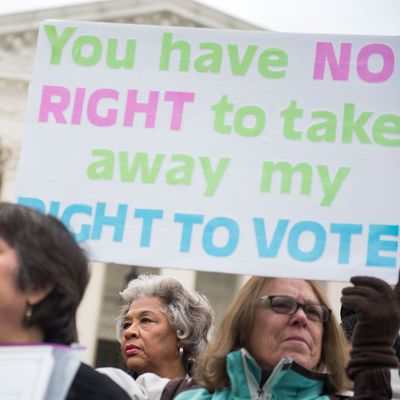
It is the kind of 5–4 decision that shows why it mattered that Mitch McConnell kept Merrick Garland off the Supreme Court so that GOP appointee Neil Gorsuch was able to occupy Antonin Scalia’s seat. Samuel Alito delivered the opinion for the conservative majority in Husted v. Philip Randolph Institute that gave the state of Ohio — famed for its highly partisan election administration regime — great leeway in designing a purge of voter rolls after narrowly construing some confusing language in the federal motor-voter legislation (officially the National Voter Registration Act of 1993) that was designed to expand voter participation.
The federal law at issue had one provision indicating how states might verify an apparent change of address by return-postage-paid notice to voters, and another banning a purge on the basis of failure to vote. Ohio wanted to initiate a purge that sent notices to voters if they missed voting for just two years, arguing that it was the subsequent failure to respond to multiple notices that triggered their removal, not failure to vote. All in all, the procedures meant someone who didn’t vote for six years and who threw out the notices could be removed from the rolls. And there was no doubt that Ohio — which has purged 2 million voters since 2011 on various pretexts — would aggressively pursue whatever avenues the courts allowed for restricting the franchise, which happens to benefit the party that has run Ohio’s electoral machinery during this period.
The four dissenters (with Stephen Breyer writing the main dissent) rejected the idea that a use-it-or-lose-it approach to voting rights is acceptable under current federal law. And in a scathing separate dissent, Justice Sotomayor reminded the Court that it was perverting the entire purpose of the motor-voter law by construing it as permissive toward voter purges — particularly those which, like Ohio’s, disproportionately affects minority voters, which the same law prohibits.
The decision doesn’t just affect voters in Ohio, as NBC News noted:
At least a dozen other politically conservative states said they would adopt a similar practice if Ohio prevailed, as a way of keeping their voter registration lists accurate and up to date.
So it might be off to the races for a new round of voter suppression, all justified by a yet-to-be-documented risk of voter fraud, and a new burden for beleaguered voting-rights activists who must now focus on educating vulnerable communities on how to avoid or mitigate purges.
Aside from showing the importance of who does and does not get confirmed for the Supreme Court, the decision illustrates the weakness of federal voting-rights laws. If there was a clearly, solidly established presumption in favor of the right to vote and a difficult set of obstacles for would-be vote suppressors to overcome, decisions like this would be hard to write. But on the other hand, that’s the kind of law that was in place for jurisdictions subject to the pre-clearance provisions of the Voting Right Acts of 1965 (whereby suspicious changes in voting procedures had to be approved in advance by the Justice Department) until the Supreme Court gutted it in the 2013 Shelby County v. Holder decision. Currently Congress, the Justice Department, and a big majority of states are under the control of a Republican Party that has all but abandoned any interest in vindicating voting rights. Combine that with a SCOTUS majority that is equally indifferent if not hostile and you have a terrible environment for the fight for voting rights that stretches all the way back to the premature hopes aroused by the 15th Amendment, ratified 148 years ago.
It’s unclear whether this will be a significant election issue for Democrats this year or in 2020, but it’s without question an issue where the results of those elections could have a large, real-life impact on the right to vote.






























